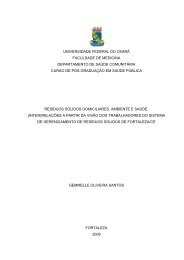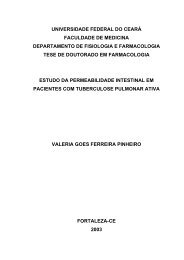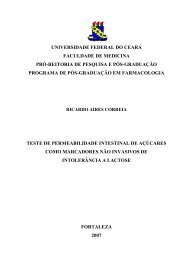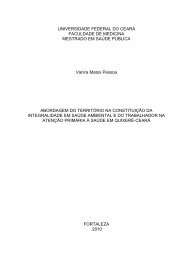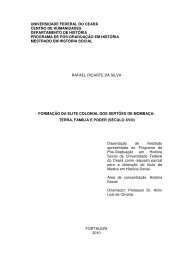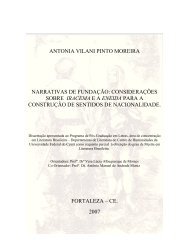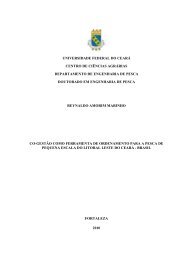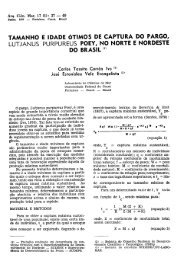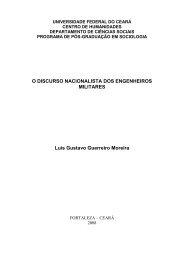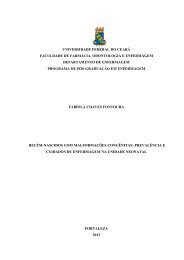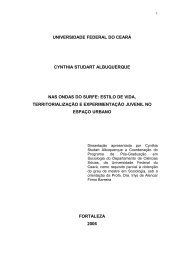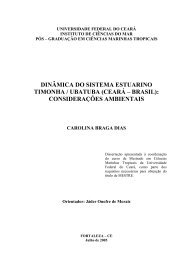Tungíase: doença negligenciada causando patologia grave
Tungíase: doença negligenciada causando patologia grave
Tungíase: doença negligenciada causando patologia grave
You also want an ePaper? Increase the reach of your titles
YUMPU automatically turns print PDFs into web optimized ePapers that Google loves.
Table 3. Population attributable fractions of modifiable<br />
factors associated with tungiasis.<br />
Floor of sand or clay inside the<br />
house<br />
Common resting place outside<br />
house<br />
without elevated costs. For example, cementing the floors of those<br />
houses with sandy or clay floor in the community would reduce<br />
prevalence of tungiasis by almost 75%. In addition, this measure<br />
will reduce transmission on the long run without any additional<br />
costs for the next years. Similar, confining pigs to pigpens and<br />
explaining to community members the location of breeding sites<br />
and areas of high transmission would reduce considerably the<br />
prevalence in the community. As a spin-off, the discussed measures<br />
References<br />
Attributable<br />
risk<br />
% exposed<br />
among cases PAF<br />
0,89 82.5 73.7<br />
0,86 76.2 65.5<br />
Regular use of footwear 0,66 77.4 51.1<br />
Presence of pigs on compound 0,94 40.1 37.9<br />
doi:10.1371/journal.pntd.0000087.t003<br />
1. Heukelbach J, de Oliveira FA, Hesse G, Feldmeier H (2001) Tungiasis:<br />
a neglected health problem of poor communities. Trop Med Int Health 6:<br />
267–272.<br />
2. Ehrenberg JP, Ault SK (2005) Neglected diseases of neglected populations:<br />
thinking to reshape the determinants of health in Latin America and the<br />
Caribbean. BMC Public Health 5: 119.<br />
3. Molyneux DH, Hotez PJ, Fenwick A (2005) ‘‘Rapid-impact interventions’’: how<br />
a policy of integrated control for Africa’s neglected tropical diseases could benefit<br />
the poor. PLoS Med 2: e336.<br />
4. Franck S, Feldmeier H, Heukelbach J (2003) Tungiasis: more than an exotic<br />
nuisance. Travel Medicine and Infectious Disease 1: 159–166.<br />
5. Heukelbach J (2005) Tungiasis. Revista do Instituto de Medicina Tropical de<br />
São Paulo 47: 307–313.<br />
6. Feldmeier H, Heukelbach J, Eisele M, Sousa AQ, Barbosa LM, Carvalho CB<br />
(2002) Bacterial superinfection in human tungiasis. Trop Med Int Health 7:<br />
559–564.<br />
7. Joseph JK, Bazile J, Mutter J, Shin S, Ruddle A, Ivers L, Lyon E, Farmer P<br />
(2006) Tungiasis in rural Haiti: a community-based response. Trans R Soc Trop<br />
Med Hyg 100: 970–974.<br />
8. Feldmeier H, Eisele M, Saboia-Moura RC, Heukelbach J (2003) Severe tungiasis<br />
in underprivileged communities: case series from Brazil. Emerg Infect Dis 9:<br />
949–955.<br />
9. Obengui (1989) La tungose et le tétanos au C.H.U. de Brazzaville. Dakar Med<br />
34: 44–48.<br />
10. Tonge BL (1989) Tetanus from chigger flea sores. J Trop Pediatr 35: 94.<br />
11. Hoeppli R (1963) Early references to the occurrence of Tunga penetrans in<br />
Tropical Africa. Acta Trop 20: 143–152.<br />
12. Njeumi F, Nsangou C, Ndjend AG, Koga, Ostanello F, Pampiglione S (2002)<br />
Tunga penetrans au Cameroun. Revue Méd Vét 153: 176–180.<br />
13. Ugbomoiko US, Ofoezie IE, Heukelbach J (2007) Tungiasis: High prevalence,<br />
parasite load and morbidity in a rural community in Lagos State, Nigeria.<br />
Int J Dermatol 46: 475–481.<br />
14. Heukelbach J, Wilcke T, Harms G, Feldmeier H (2005) Seasonal variation of<br />
tungiasis in an endemic community. Am J Trop Med Hyg 72: 145–149.<br />
15. González A, de Villalobos C, Ranalletta MA, Coscarón MC (2004) Aspectos<br />
adaptativos y biológicos de Tunga penetrans (Linné 1758). Epidemiología en<br />
comunidades aborígenes del norte argentino. Arch Argent Dermatol 54:<br />
119–123.<br />
16. Muehlen M, Feldmeier H, Wilcke T, Winter B, Heukelbach J (2006) Identifying<br />
risk factors for tungiasis and heavy infestation in a resource-poor community in<br />
Northeast Brazil. Trans R Soc Trop Med Hyg 100: 371–380.<br />
17. Heukelbach J, Wilcke T, Eisele M, Feldmeier H (2002) Ectopic localization of<br />
tungiasis. Am J Trop Med Hyg 67: 214–216.<br />
probably reduce also the transmission of other parasitic diseases,<br />
such as neurocysticercosis, ancylostomiasis and strongyloidiasis.<br />
In conclusion, the presence of tungiasis in the community is<br />
associated to an important extent with a set of a few modifiable<br />
variables. Effective and sustainable intervention measures addressing<br />
these factors need to be implemented in the study area, and in<br />
other communities throughout West Africa, to reduce the burden<br />
of this neglected tropical disease. An integrated approach<br />
combining the control of animal reservoirs, housing and<br />
environmental factors, and health education is necessary. Intervention<br />
measures need to be designed by an interdisciplinary<br />
team together with the affected communities.<br />
Acknowledgments<br />
We thank the Baales and Ajido Erekiti communities for supporting the<br />
study and Mr. Durotimi Ashade and Mr. Ola Avhose for skillful assistance.<br />
LA received a PhD scholarship from Coordenação de Aperfeiçoamento de Pessoal<br />
de Nível Superior–CAPES (Brazil).<br />
Author Contributions<br />
Tungiasis in Nigeria<br />
Conceived and designed the experiments: JH UU IEO. Performed the<br />
experiments: UU. Analyzed the data: JH UU LA. Contributed reagents/<br />
materials/analysis tools: JH. Wrote the paper: JH UU IEO LA.<br />
18. Eisele M, Heukelbach J, van Marck E, Mehlhorn H, Meckes O, Franck S,<br />
Feldmeier H (2003) Investigations on the biology, epidemiology, pathology and<br />
control of Tunga penetrans in Brazil: I. Natural history of tungiasis in man.<br />
Parasitol Res 90: 87–99.<br />
19. Heukelbach J, Mencke N, Feldmeier H (2002) Editorial: Cutaneous larva<br />
migrans and tungiasis: the challenge to control zoonotic ectoparasitoses<br />
associated with poverty. Trop Med Int Health 7: 907–910.<br />
20. Heukelbach J, Costa AM, Wilcke T, Mencke N, Feldmeier H (2004) The animal<br />
reservoir of Tunga penetrans in severely affected communities of north-east Brazil.<br />
Med Vet Entomol 18: 329–335.<br />
21. Carvalho RW, Almeida AB, Barbosa-Silva SC, Amorim M, Ribeiro PC, Serra-<br />
Freire NM (2003) The patterns of tungiasis in Araruama township, state of Rio<br />
de Janeiro, Brazil. Mem Inst Oswaldo Cruz 98: 31–36.<br />
22. Rietschel W (1989) Beobachtungen zum Sandfloh (Tunga penetrans) bei Mensch<br />
und Hund in Französisch-Guayana. Tierärztliche Praxis 17: 189–193.<br />
23. Cooper JE (1976) Tunga penetrans infestation in pigs. Veterinary Records 98: 472.<br />
24. Cooper JE (1967) An outbreak of Tunga penetrans in a pig herd. Veterinary<br />
Records 80: 365–366.<br />
25. Verhulst A (1976) Tunga penetrans (Sarcopsylla penetrans) as a cause of agalactia in<br />
sows in the Republic of Zaire. Veterinary Records 98: 384.<br />
26. Pampiglione S, Trentini M, Gentili FM, Mendes JLX, Pampiglione C, Rivasi F<br />
(1998) Tunga penetrans (Insecta: Siphonaptera) in pigs in São Tomé (Equatorial<br />
Africa): Epidemiological, clinical, morphological and histopathological aspects.<br />
Revue Élev Méd vét Pays trop 51: 201–205.<br />
27. Heukelbach J, Costa AM, Wilcke T, Mencke N, Feldmeier H (2004) The animal<br />
reservoir of Tunga penetrans in severely affected communities of north-east Brazil.<br />
Med Vet Entomol 18: 329–335.<br />
28. Muehlen M, Heukelbach J, Wilcke T, Winter B, Mehlhorn H, Feldmeier H<br />
(2003) Investigations on the biology, epidemiology, pathology and control of<br />
Tunga penetrans in Brazil II. Prevalence, parasite load and topographic<br />
distribution of lesions in the population of a traditional fishing village. Parasitol<br />
Res 90: 449–455.<br />
29. Wilcke T, Heukelbach J, Cesar Saboia MR, Regina SK-P, Feldmeier H (2002)<br />
High prevalence of tungiasis in a poor neighbourhood in Fortaleza, Northeast<br />
Brazil. Acta Trop 83: 255–258.<br />
30. Chadee DD (1998) Tungiasis among five communities in south-western<br />
Trinidad, West Indies. Ann Trop Med Parasitol 92: 107–113.<br />
31. Arene FO (1984) The prevalence of sand flea (Tunga penetrans) among primary<br />
and post-primary school pupils in Choba area of the Niger Delta. Public Health<br />
98: 282–283.<br />
32. Ade-Serrano MA, Ejezie GC (1981) Prevalence of tungiasis in Oto-Ijanikin<br />
village, Badagry, Lagos State, Nigeria. Ann Trop Med Parasitol 75: 471–472.<br />
PLoS Neglected Tropical Diseases | www.plosntds.org 7 2007 | Volume 1 | Issue 3 | e87



